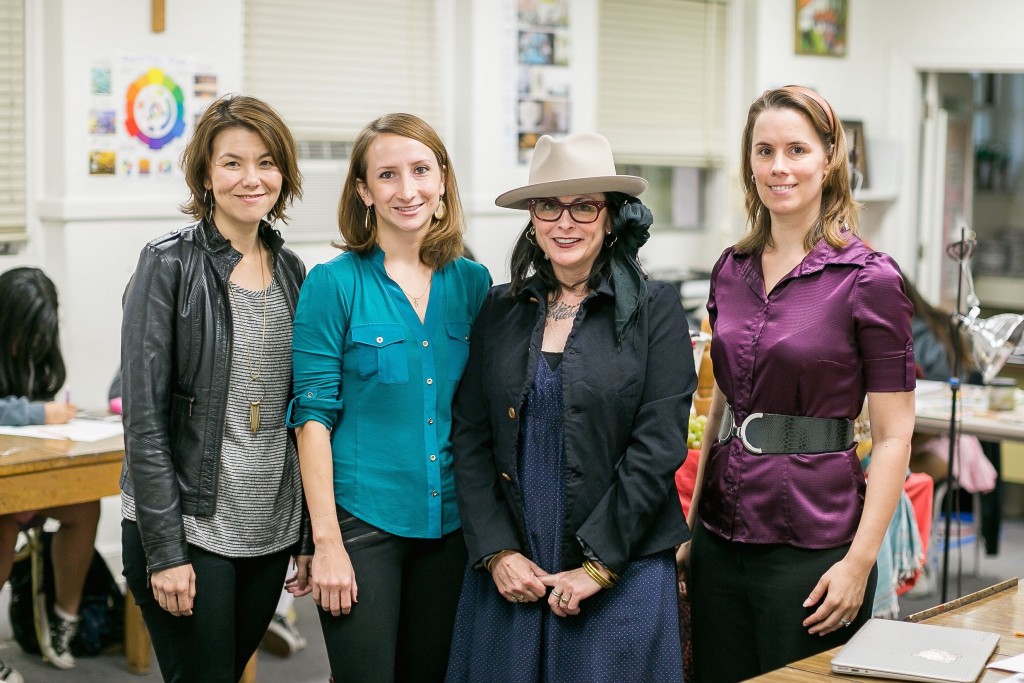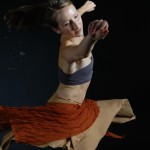The artsy ones—every school has them. The kids that spend their afternoons and weekends backstage building sets. The ones with paint splatter on their clothes. The girls that can’t stop humming and singing and dancing … even when they aren’t on the stage.
Julie Vogel ’81, Shannon Morzov ’94, Sarri Sanchez ’01 and Allison Lieskovsky Hasbrouck ’00 are four such Tologs who fell in love with the arts as students at Flintridge Sacred Heart Academy. We sat down with these dynamic alumnae to find out how FSHA shaped their artistic vision, how they turned their passions into careers and what advice they have for students interested in the arts today.

When you were on the Hill, what was your involvement in the arts?
Allison Lieskovsky Hasbrouck: I took AP Art my senior year, but I took art classes outside of school before that. I was also part of the theatre crew. I was not very good onstage, but I did a lot of the backstage stuff—making props, costumes, hair and makeup. I also did some of the designs for the theatre posters before we did it all digitally.
Shannon Morzov: I was also really involved in theatre. I started taking drama freshman year. I was on the ComedySportz team. I was in the plays. And I always wanted to do film. What helped me here is that … I don’t sing. It’s scary. I really don’t sing at all and spring productions have always been musicals. There is no possible way for me to do that. So I started tech-ing. I did stage managing, assistant directing, lights, sound, building sets and I loved it. That was my first introduction to that tech world and that parlayed into filmmaking later.
Sarri Sanchez: I took every dance class that was offered here every year and I participated in every Dance Concert. I choreographed every year and was part of the dance company. Every dance opportunity that was there, I tried to take it.
Julie Vogel: I took art classes and sewing every year. I don’t know how I got so many electives, but I did. I made everyone’s prom dresses. (laughter) I made six prom dresses a year, and everyone would just trade. I took dance for my P.E. and I did theatre with Ms. TM [Talbot-Martin]. And I worked on the yearbook. I feel like I took a lot of creative classes here.
Who was your favorite art teacher at FSHA?
Julie: I was super close to Schuyler [Standish]. He taught art and kind of pushed me to go to art school. He was really supportive of that. I learned everything from Schuyler … how to paint (which is my main art outside of my job), but I include my job, my house, my life. Everything is art, everything is a collage. I feel like I learned so many different medias from him.
Sarrie: Pam Santelman. She was my first and most important mentor. I was so, so, so shy when I was here and dance was really the first thing that made me want to appear in the world. Pam introduced me to modern dance—what I went on to pursue for my life. She challenged me to think critically through dance. Not to think of this as “just” an elective, but really as a way to engage with things that are urgent to you and things that you are passionate about.
Shannon: Mr. Bailey. I was actually in the first class he taught here. When he first came on as the drama teacher, it was like, “Oh, the ComedySportz guy is going to be the drama teacher. Like, seriously?” But when he got here, he took theatre seriously. He took us seriously as theatre students. He pushed us to do Shakespeare and Beckett and all this crazy experimental stuff that you wouldn’t expect from a Catholic school. He really pushed the craft and taught us that there was a seriousness and a process to theatre and drama.

Allison: Even though I am a fine artist and I did have Schuyler Standish, I only had him my senior year. He did push for me to go to art school and he helped me get my portfolio together. But the teacher I remember giving me the most support was actually James Bailey because I was backstage so much doing the creative stuff, like building props, helping with hair and makeup. That really pushed me to open up and I realized that everything could be incorporated in fine art. Creativity can be used in multiple outlets.
When did you decide that you would be an artist? That it would be your career?
Sarri: I didn’t have an ah-ha moment of figuring out that dance is what I wanted to do. I think I knew both early on and not until much later—and I still keep deciding. Probably the first time I thought of it, when I considered dance a potential career path, was here. I knew then that I wanted to continue to study dance and that it was a valid and worthwhile path to pursue in college. When I went to UCLA, that’s when I knew I had to keep making dances [as a choreographer], that’s as much as I knew. When I started teaching, that’s when I knew I had to keep teaching. Then I went to grad school and I recommitted again. I am all of these things—I need to dance, I need to create, I need to mentor. And so I keep asking myself and I keep recommitting myself. It’s a complicated answer: In high school or yesterday.
I feel like there is nothing in me that isn’t an artist. — Julie Vogel ’81
Julie: I think I knew I was an artist from day one. I grew up in such a creative family. They are all ceramicists, artists. I felt like that was my path. I never really thought that I wouldn’t be an artist. I feel like there is nothing in me that isn’t an artist. And it’s funny, what [Sarri] said. Was it yesterday or … I mean, everyday I wake up and I’m like, Am I a fraud? Am I really doing this? What do I know?
Allison: I always kind of knew that I was an artist. I think if I didn’t have the parents that I did or the support system here [at FSHA], I would not have become an artist. My parents were like “You should do this. You are good at it,” instead of saying, “Oh, how is that going to work? How are you going to pay the bills or make a living?”
Shannon: When I got to Flintridge Sacred Heart, it was the early ’90s and it was a super exciting time for indie filmmaking. Indie filmmaking was just crazy and insane. Tarantino was new. It was just a cool time. I just knew that that is what I wanted to do. I knew I wanted to make movies. And as I said, I started doing some tech and stage managing, backstage and directing … and it was really awesome.
Did you get support from your parents? Or support from FSHA?
Sarri: I felt supported here and at home, but not without some reservations. I definitely had conversations with my parents where they said, “This is great. You should definitely pursue this … as a hobby.” (laughter) I know they were concerned and they wanted to make sure that I would be OK. I heard them. Ultimately, my parents became 100 percent supportive of what I chose to do and I felt like the same was true at FSHA. I felt like I had people behind me and people that believed in my choice. I remember someone outside the context of Flintridge Sacred Heart saying to me, when I mentioned I would go into dance, they said “But you are so smart, you can go on and do whatever you want to do.” I was like, “I am! I am doing what I want to do.” (laughter)
My dad wanted me to go to med school and my mom wanted me to be a lawyer … but I wanted to be a filmmaker. And for graduation my dad bought me my first video camera.” –Shannon Morzov ’94
Shannon: My dad wanted me to go to med school and my mom wanted me to be a lawyer … but I said I wanted to be a filmmaker. And for graduation my dad bought me my first video camera. So, as much as he wanted—and he still wanted me to go to med school—he bought me the video camera because he knew that that was what I wanted to do. One thing I really love about my parents is that they were supportive when they really didn’t want to be. It was really hard for them.
Julie: I felt like everyone in my class was going onto medical school or going to law school. Everybody seemed very academic. I got good grades, but I definitely didn’t feel like med school or law school was what I wanted to do. My family was supportive, though my mother definitely said, “You’re never going to make money.” So I did have that, but I knew if I followed my heart, it would be OK.
Allison: I don’t ever remember my parents having a really serious conversation with me about how would I support myself if I pursued art. It was always people outside of the school and outside of my family that would be asking, “What are you going to do?” Even now I have students that I teach where they tell me, “My parents don’t know what this is, how can I explain to them what I do?” And I have to explain to them the variety of things that art majors can do. An art degree is a very versatile tool to have.
What advice would you give to a student that wanted to go into your field?
Allison: I had this conversation with my students just a few weeks ago. The ones that have parents that are creative don’t have as much of an issue about their daughter going to art school, but I have girls who are extremely creative and the parents don’t want them to go to art school because they don’t think it will lead to a lucrative job opportunity. That’s when I say, “If you’re good at it, you will find a way to make money doing it. If you’re really passionate, there will be opportunities.”

When I was at FSHA as a student, I didn’t think I would end up back at the school teaching the art program, but it turns out that this is how I am able to use my talent and support myself on it. It’s not easy to be an artist, but it’s not impossible. Everyone assumes that art making is an old, antiquated way of making living, but it’s not. It’s changed and been remolded with technology and media.
Shannon: I agree with a lot of what [Allison] said. I think entertainment is a little different. Entertainment is very much an industry, a business. There’s work if you want to work in film or filmmaking. You just have to make a decision—is this my life or not? Make the decision that this is what you want your life to be and you will figure it out.
As far as film school, I think it’s actually a waste of time. Filmmaking is story telling and if you want to tell stories, study anthropology or sociology. Have something to say. To work in film, really the best thing to do is just start working. I mean, go to school, go bum around Mexico, do whatever you need to do to get some things behind you, then just start working. P.A. [production assistant] for free, work for other people, find someone to mentor you, find a director to work for or a producer, but just start working.
Life is cyclical and it all changes. You just decide what’s important to you. If you love it, you’re going to have a good living. And you have to decide what’s a good living mean for you and what’s important to you.
Sarri: I’m only 31, but I have a lot of advice already. Follow your desires. Be ambitious, but sometimes you need to replace ambition with curiosity. Sometimes art making feels like magic and sometimes it feels like work. Value both equally. Be prepared to change your mind. Embrace surprises. I think the most important thing I would say is know that your future career might not exist yet and it may not exist until you create it. That’s certainly what happened to me.
Dance was the first thing that made me want to appear in the world. –Sarri Sanchez ’01
The whole idea of there even being a path is so weird and kind of misleading. A path is something that you choose and just goes forward, but it’s not always that clear cut. Sometimes it’s like walking through a dense fog. You don’t know what’s out there. Things only crystallize as you take one step into them. You don’t have to see the whole path. You have to know that you can’t live without your art. If someone wants to pursue dance, if you know you cannot live without it, do it. You will find a way to make it happen. The whole starving artist, lonely artist idea, I think it’s a myth. You don’t have to believe that. You don’t have to buy into that.
Julie: Everything that you all said is so funny and great. What Sarri said about a path, I’m telling you there are so many forks! And you never know where it’s going to lead you. I love that! In a way, you have to be strong if you’re in the arts. It’s not about you, but is about you.
To be a costume designer, look at every movie. Who’s designing it? Look that person up. Send the designer a message through her agent or through the union. Tell the designer that you want to intern. Tell her you want to P.A. Everybody needs a good PA. I find now, these days, that kids coming out of college are so lazy. They don’t want to do anything. They don’t want to pay their dues. I paid my dues. I paid my dues last month. I pay my dues constantly. I’ll do a free job because I’m open and I’ll always meet someone who is amazing and will take me on a fork that I wasn’t planning on going. It’s about always being open and following your heart.
Shannon: One thing to point out about interns: We have a lot of interns and most of them are really terrible. If you are a good intern, you stand out. If you are a good intern and I think you are good, I’m going to offer you a job because it’s easy for me. I’ve seen your work. I know you’re good at what you do. I don’t have to test you out.
The entertainment industry is very small so people talk with one another all the time. They always say, “Do you know someone good?” And if I do, I go will recommend them, but I’m not going to recommend someone who is terrible.
Sarri: I think this is definitely true for dance, but I think this is also true for the other arts—find people to collaborate with. You need other people. You’re not going to do it on your own. That has been imperative for me, in all areas.
Allison: I always tell my students that you have to put in the work. When you put in the work, people see the work. It’s obvious. If you decide to go into the arts, you have to work hard at it. If you start at the bottom, you have to be OK about starting on the bottom. Eventually you will climb. And the ones who don’t want to start at the bottom, they go wayward. It’s not just the arts—whatever you do—you have to work hard at it. You can’t expect to make it as soon as you graduate.
Shannon: Part of being an artist is that it’s work. You have to have a job, everyone has to pay rent and eat food, but you have to make time to pursue art on your own time as well. If you have to get up at six in the morning to write for two hours, that’s what you do. It’s work and the people who are successful are the people who treat it as the work it is.
About Our Alumnae Artists
Julie Vogel ‘81
 If you know who the “Most Interesting Man in the World” is, then you’ve seen Julie Vogel’s work. As a commercial costume designer, Julie has dressed hundreds of actors, including the infamous Dos Equis’ spokesman. She has also worked on commercials for brands such as Advil, T-Mobile, Priceline, Coca-Cola and Geico, just to name a few. For her work on the Dos Equis’ campaign, Julie has been nominated five times for “Excellence in Commercial Costume Design” at the Annual Costume Designers Guild Awards.
If you know who the “Most Interesting Man in the World” is, then you’ve seen Julie Vogel’s work. As a commercial costume designer, Julie has dressed hundreds of actors, including the infamous Dos Equis’ spokesman. She has also worked on commercials for brands such as Advil, T-Mobile, Priceline, Coca-Cola and Geico, just to name a few. For her work on the Dos Equis’ campaign, Julie has been nominated five times for “Excellence in Commercial Costume Design” at the Annual Costume Designers Guild Awards.
Shannon Morzov ’94
 Shannon Morzov ’94 lives in the movies. As general manager for Hurwitz Creative, an award-winning creative content company that produces marketing for the film and television industry, Shannon has overseen the creation of trailers, behind-the-scenes footage and featurettes for such blockbusters as “The Fault in our Stars,” “Life of Pi” and “Prometheus.” As a student at UC Berkeley, Shannon won the Eisner Film Prize for her documentary “No Trespassing: Sovereignty at Risk,” about Native American gaming rights.
Shannon Morzov ’94 lives in the movies. As general manager for Hurwitz Creative, an award-winning creative content company that produces marketing for the film and television industry, Shannon has overseen the creation of trailers, behind-the-scenes footage and featurettes for such blockbusters as “The Fault in our Stars,” “Life of Pi” and “Prometheus.” As a student at UC Berkeley, Shannon won the Eisner Film Prize for her documentary “No Trespassing: Sovereignty at Risk,” about Native American gaming rights.
Allison Lieskovsky Hasbrouck ’00
 You never really leave the Hill. Just ask Allison Lieskovsky Hasbrouck ’00. In 2006, Allison joined the faculty at FSHA as the new art teacher. She teaches 2D Art, AP Art History and AP Drawing, as well as moderates the Art Club. Primarily a painter, Allison has also won awards for her own artwork, including Honorable Mention at the La Crescenta Paint Out Loud competition.
You never really leave the Hill. Just ask Allison Lieskovsky Hasbrouck ’00. In 2006, Allison joined the faculty at FSHA as the new art teacher. She teaches 2D Art, AP Art History and AP Drawing, as well as moderates the Art Club. Primarily a painter, Allison has also won awards for her own artwork, including Honorable Mention at the La Crescenta Paint Out Loud competition.
Sarri Sanchez ’01
 As a dancer, teacher and choreographer, Sarri Sanchez ’01 can often be found on the stage. For the past nine years, Sarri has taught dance at Renaissance Arts Academy, a K-12 public charter school that specializes in music and the performing arts. Sarri has also performed with several distinguished artists, including Liz Hoefner Adamis, Mike Kelley, Maria Gillespie, Invertigo Dance Theatre, L.A. Contemporary Dance Company, and most prominently, as a founding member of Holly Johnston’s Ledges and Bones. In addition to her work as a performer, Sarri serves as choreographer and artistic co-director of two collaborative performance groups: IN/EX Dance Project and The Rock Collection.
As a dancer, teacher and choreographer, Sarri Sanchez ’01 can often be found on the stage. For the past nine years, Sarri has taught dance at Renaissance Arts Academy, a K-12 public charter school that specializes in music and the performing arts. Sarri has also performed with several distinguished artists, including Liz Hoefner Adamis, Mike Kelley, Maria Gillespie, Invertigo Dance Theatre, L.A. Contemporary Dance Company, and most prominently, as a founding member of Holly Johnston’s Ledges and Bones. In addition to her work as a performer, Sarri serves as choreographer and artistic co-director of two collaborative performance groups: IN/EX Dance Project and The Rock Collection.
Visit visionforveritas.org for information about FSHA’s Arts Center Remodel, which is ushering in a new era for the arts.





Hello FSHA ! I was the Tennis Coach from 1980-85, and my name is Gary Benedetti ! I have GREAT Memories of FSHA and I wish them all the best !!! I still work out everyday with tennis and weights and I hope everybody up there, faculty and students, are healthy !!! Take care all of you !!!